#is it not enough that i execute on all your dumb redesigns?
Explore tagged Tumblr posts
Text
Please list your most significant accomplishments in addition to development areas regarding your performance in 2023.
I dunno? Surviving? Not blowing up the servers in a fit of rage? Still haven't quit yet???
Please define 3-5 goals and dates for achievement during the 2024 performance year.
I dunno. The same as last year???
#seriously at the point of going#“what? are you going to fire me for not having goals?”#is it not enough that i execute on all your dumb redesigns?#stop asking me to self-reflect#makes me ready to fucking kms
9 notes
·
View notes
Note
now that it's over, thoughts on Bendis' Superman as a whole?
pretenderoftheeast said: So, thoughts on Bendis' Superman and Action Comics' tenure altogether and separately now that it's over?
Anonymous said: Best and Worst things about Bendis' Superman run
Anonymous said: Now that it is over, what are your thoughts on Bendis' runs on Superman and Action Comics as a whole?
Anonymous said: Retrospective thoughts on Bendis' Superman as a whole now that it's, I guess, done?
Anonymous said: Hey so since Bendis’ Superman stuff seems to be done, what did you think of the run as a whole?

I decided to hold off a bit on writing on this one, if only so that I could reread the Action Comics side of it since Superman stood out in my memory a lot more. But now I have, and as we’re heading into a bold new era of Superman (and it’s coming in fast - just since I made my Superman in 2021 predictions we’ve gotten Ed Pinsent finally reprinting his legendary bootleg Silver Age Superman, Steve Orlando announcing his Superman analogue book Project Patron, an official shonen Superman redesign for RWBY/Justice League, PKJ’s Super-debut turning out far better than I ever expected, Superman & Lois’s first proper trailer largely taking people pleasantly by surprise, and my learning that there’s a Sylvester Stallone Old Man Superman analogue movie titled Samaritan coming out this summer) we’re ready to take a look back with at least a touch of perspective. I’ll lead with complaints, so everybody who’s been waiting for me to say that Bendis on Superman was Bad, Actually, savor this because it’s as close as you’ll get.
The Bad
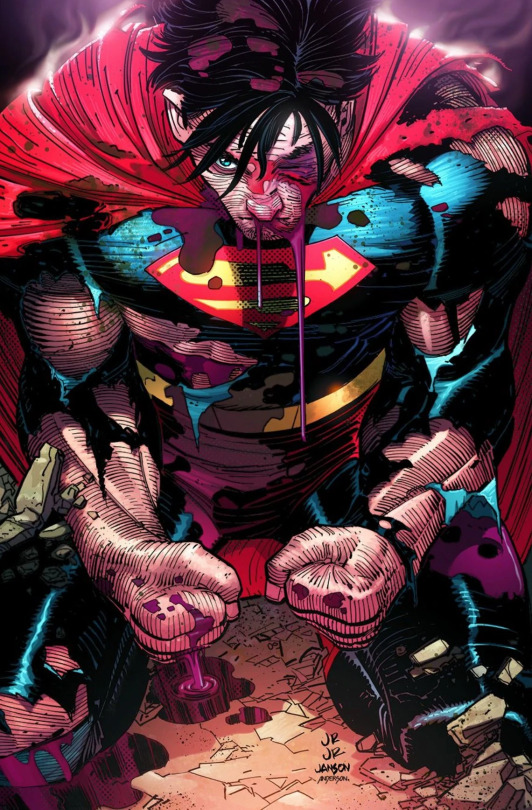
* I hate to say it, but rereading that side of the run there’s no two ways about it: the structure of Action Comics as a whole is a mess. It baffled me from day one that it was the more acclaimed of the two books for so long - I guess people are hardwired at this point to think of ‘street’ stuff as where Bendis is supposed to be - because it was immediately clear that Superman had a well-defined story he wanted to tell, while Action was the usual Bendis off-the-cuff improvisation. It’s barely even a story in the same way, and it’s certainly not the ‘Metropolis crime book’ people took it as: it’s 28 issues of Superman and his supporting cast stuffed a pinball machine with the Red Cloud pinging off of each other as we wait to see who falls in the hole at the bottom, and partway through Leviathan and the Legion of Doom and 90s Superboy are tossed into the mix to keep it going a little longer. On an issue-to-issue basis it’s frequently really good, but the core plot of the book is *maybe* six issues stretched out over two and a half years.
* I’ve gone into this some before, but structure-wise Unity Saga also has problems: Phantom Planet rules but either it needed to be cut or the back half needed to be a year all its own in order to accommodate the scale of what it’s attempting. It’s got an interstellar civil war leading into the formation of the United Planets, family drama, Rogol Zaar’s whole deal, and Jon’s coming of age, and I’d say only that last one is really properly served. Even Jon forming the United Planets, while contextually somewhat justified in terms of 1. The situation being so far gone he’s the only one who’d even think in those terms, 2. Things being bad enough that these assorted galactic powers would be willing to try it, and 3. Him having the S on his chest to sell it, isn’t at all built up to within the run itself.
* Rogol Zaar sucks. He’s made up of nothing but interesting ideas - he’s an ersatz warrior ‘superman’ of a bygone age of empires up against the new model, he’s the sins of Krypton as a conservative superpower come home to roost, he’s while not outright said to be definitely Superman’s tragic half-brother and the culmination of everything this run does with Jor-El - but none of them manifest on the page, he’s just a big punchy dude with a dumb design who screams about how you should take him seriously because he’s totally the one who blew up Krypton. Even a killer redesign by Ryan Sook for Legion of Superheroes can’t fix that. There are lots of bad villains with good ideas who are redeemed with time and further effort, but I can’t imagine Zaar getting that TLC to become a fraction of whatever Bendis envisioned him as.
* The second year of Action Comics, after establishing itself in its first as one of the most consistently gorgeous books on the stands, leads with Szymon Kudranski’s weak output and then concludes with John Romita Jr. turning in some career-worst work. The latter is particularly egregious because for that first year Bendis writes a really collected, gentle Superman so him getting pushed into being more aggressive should have an impact, but Romita draws such a craggy rough-looking Superman in the first place that it mutes any sort of shock value.
* WE NEVER LEARN WHAT’S UP WITH LEONE’S CAR, WHAT THE HELL. You don’t just DROP THAT IN THERE and then NEVER FOLLOW UP.
The Good
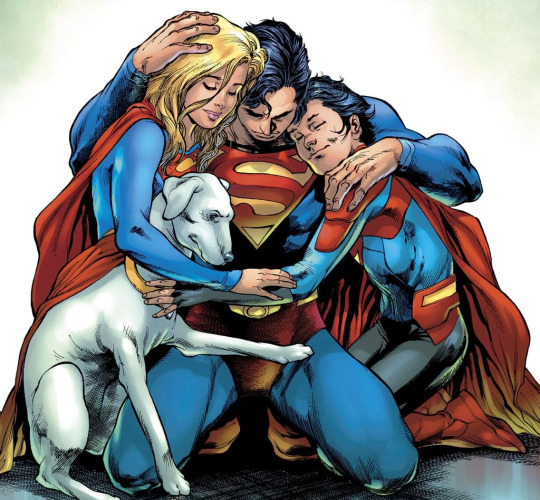
* Superman got his real clothes back after 7 truly ridiculous years.
* Bendis fundamentally gets Clark’s voice in a way unlike almost any other writer - even all-around better writers of the character almost never approach how spot-on he is with having Superman speak and act exactly how Superman should.
* Supporting cast front and center! He writes a dynamite Lois, Perry, and Jimmy (even if many of Lois’s more out-there decisions in the run don’t end up retroactively justified the way you’d hope), Ma and Pa are more fun than they’ve been in decades in their brief appearances, he manages to turn having Jor-El in the mix into a positive, and the Daily Planet as a whole has an incredibly distinctive vibe to it like never before that I hope is taken as a baseline going forward.
* The non-Rogol Zaar baddies? All ruled. Invisible Mafia and Red Cloud are both brilliant ideas executed solidly if overextended. Zod as Kryptonian Vegeta, Mongul as a generational perpetual bastard engine primed to be incapable of self-reflection, and Ultraman as “what if Irredeemable but he’d never been a good guy and also he was a Jersey mobster” are the best versions of those characters by numberless light-eons. Lex is on-point in his sparse appearances. Xanadoth as a mystical cosmic monster older than time who still talks like a Bendis character is however unintentionally a hoot. The alt-universe Parasite is a more intimidating Doomsday than Doomsday ever was. And Synmar as an alien culture’s attempt at creating their own Superman and messing up the formula when they make him a soldier can and should be a legitimate major ongoing villain coming out of this run.
* Pretty much all the art other than what I mentioned already. Fabok does a good job bookending The Man of Steel and Ivan Reis does the work of his career anchoring Superman (special props to Reis as well for drawing the first ever non-Steve Rude interesting-looking take on Metropolis), and meanwhile you’ve got Jim Lee, Jose Luis Garcia Lopez, Doc Shaner, Steve Rude, Kevin Maguire, Adam Hughes, Patrick Gleason, Yanick Paquette, Ryan Sook, Brandon Peterson, and David Lafuente doing their own parts.
* Closely related to the art, all the little flourishes with the powers. Super-speed having a consistent visual with the background coloring changing, Clark internally putting numbers to the degrees of force behind his punches and what situations which numbers are appropriate for, ‘skidding to a halt’ mid-flight before crashing through a window, the shonen-ass major throwdowns as portrayed by Reis, how his super-hearing is handled as a prevalent element. Lots of clever bits that added flavor to what he does.
* While Unity Saga has problems, the whole of what Bendis does in Superman as a means of forward momentum for Clark and his world is excellent. The sort of three-act structure of:
** Clark is led to question his place in things over the course of a few adventures
** Involvement in the larger cosmos and the impact it has had through and on his family makes him realize the answer to his questions is that he needs to step up in a bigger way because there’s no benevolent larger universe to welcome Earth with open arms, nor a cosmic precedent for everything turning out for the best without some help
** As a consequence of the lessons learned by this change in the status quo Clark is inspired to make his own personal change in revealing his identity (with Mythological basically being an epilogue showcasing a ‘standard’ standalone Superman adventure while simultaneously highlighting his new status quo and how it fits in as a summing-up of Bendis’s take)
…does a great job of shepherding through ideas that lend a lot of forward momentum to Superman of the kind he hasn’t seen in a long time. Not perfect, but far lesser stories with far lesser ambitions have made huge impacts, so I’d certainly hope at least some of this sticks around even if, say, regardless of any retcons to the main line there are always going to be stories with Clark as a disguise and Jon as a kid. Oh, speaking of whom,
* KISS MY ASS, EVERYTHING WITH JON KENT RULED
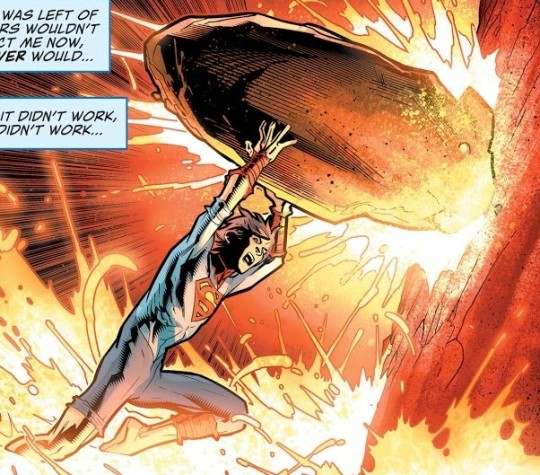
Ahem. Probably a less confrontational way of putting that.
Do I think there was more gas in the tank for Jon as a kid? Totally, making him likeable and viable was the one really good thing the Rebirth era accomplished for Superman and I expect we’ll continue seeing more of it in the future one way or another. But whether or not him being aged up was Bendis’s decision, or working with marching orders to set up the eventually-(kinda-)discarded 5G, the coming of age narrative here is fire. He keeps the essential Clark Kent kindness and bit of Lois Lane cheekiness that reminds you he’s still their kid, which is a combination Bendis is basically precision-crafted to write, but his trials by fire give him a background entirely unlike the by-the-numbers “and here’s how Superman’s great kid grew up to be a great superhero too” narrative you’d expect while still arriving at that endpoint. If superheroes live and die by metaphors then Jon in here is what it means to grow up written as large as possible: leaving home for the first time (and seeming to shoot up overnight!), getting into the muck of how the real world works, being beaten down by authority wearing faces you’ve been taught to trust, scrambling to get through with the whole world against you, and in the end getting through by learning to rely on your own strength while keeping your soul intact and your head held high, and even managing to speak some truth to power. It gives him a well-defined life story with room to go back to and explore the intricacies of each leg of for decades to come in a way Superman hasn’t had since the original Crisis - someone someday is going to write a The Life & Times Of The Son Of Superman miniseries and it’s going to be one of the greats - and negates any question that he’s earned his stature as the heir apparent.
* Coming out of this, Superman’s world is fascinating. He’s out but rather than giving up his day-to-day life he’s openly spending part of his life as CLARK KENT: SUPER-REPORTER and part of his job on the cape-and-tights side of things is now KAL-EL: SUPER-SPACE-DIPLOMAT, Lois Lane coruns a foundation helping people whose personal continuities have been fucked over by Crisis shenanigans, Jimmy Olsen owns the Daily Planet but is still doing Jimmy Olsen stuff because that’s how he gets his kicks, and Jon Kent is going to college in the future. I’m not anywhere near naïve enough to think that’s how things are going to be forever, or shortsighted enough to think there’s no value left in the traditional setups, but god I hope these developments stick around for a long, long time to come and potentially become the new ‘normal’ as far as the ongoing shared universe stuff goes, because it all feels like the right and promising next steps to take for the lives of these characters. However it got here, for all the pluses and minuses along the way even if I maintain the former very much outweighed the latter as a reading experience, Bendis has a lot to be proud of if that’s the legacy he leaves on these titles.
* The recap pages at the desks!
47 notes
·
View notes
Text
What I Thought Of Every Single Game I Played In 2017
2017 was a weird year for me. In terms of my personal life, it's been something of a holding pattern; I'm a year older, but I've not accomplished nearly as much as I'd liked to. I've had a lot of good times, and I've done my best, but I probably haven't made an entirely meaningful use of my lingering youth.
But on the other hand: I got to play a whole bunch of video games! 2017 was a good year for video games. It had to be a good year for something, I suppose, and if the rest of the world was going to be getting it nasty this year, video games might as well be the thing that gets its due.
This write-up is an overview of what I thought about every single game I played this year. Only games that released this year qualified for a numbered “place”, as interpreted through my own rules. Here we go!
[2015] | [2016]
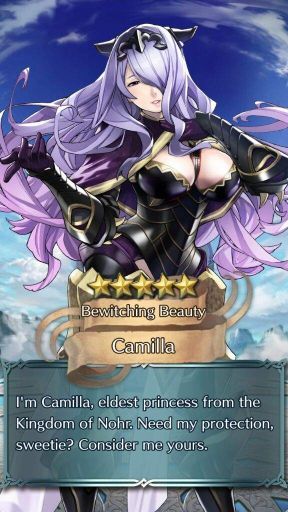
19. Fire Emblem Heroes – Android – ★★ – 2017
As a latecomer to the Fire Emblem games, this did nothing for me. I don't have a great amount of affection for the characters in the abstract, three lines of dialog and a couple cut-ins of them stabbing a guy don't even qualify as “fanservice”, and the narrative that is there is just plain bad. It's admirable that they managed to reduce their permadeath-driven tactical RPG to an experience that works on phones, but I have zero interest in throwing myself into gachapon hell in the hopes of a “dream team.” Besides, the second orb I cracked open had a five-star Camilla in it, so my experience was guaranteed to be a down-hill one.

18. Pictopix – Steam – ★★ – 2017
Pictopix is a fascinating lesson that not all Picross games are alike. It's not just a matter of creating puzzles that are secretly pixelized art: there is a flow to good nonogram design that is apparently quite hard to achieve. Where I get a lot of enjoyment from the Picross E- and Picross S- titles, I didn't care for this one, despite being on a platform well suited for a picross-a-like experience. I'm not sure I can even articulate just what rubbed me wrong about it (though the shoddy controls didn't help); the puzzles just felt clunky in a way that other takes on this style of puzzle did not.
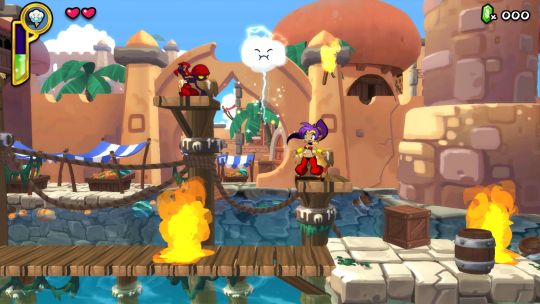
Shantae: Half-Genie Hero – Steam – ★★ – 2016
I accidentally backed this game on Kickstarter a few years ago. I thought an artist I was a fan of was attached to this project, when they just did some contracted promotional material for the Kickstarter. It's on me for reading into that, I suppose. In any case, I backed this game, it came out last year, and I couldn't honestly be bothered to actually play it until this year.
After having finally done so: I'm not sure why people like these games? They feel like baby's first platformer; it's well-produced, but threadbare in terms of mechanical complexity. There's a vague Metroidvania-aspect to re-exploring levels you've already completed, but it lacks the simple mechanical joy that the best of those have. The characters don't really do anything for me either; I presume if you've been following these since the mid-90s you get something from their interactions, because personally I just find it kind of lame? The art is fantastic, and the game looks good in motion, but overall, it's just not for me.
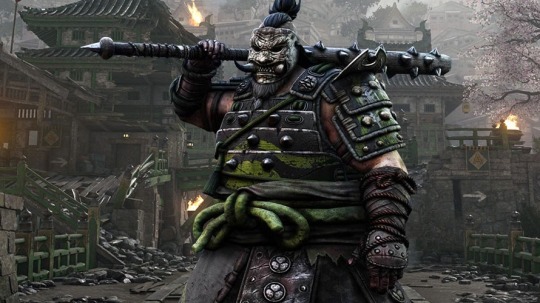
17. For Honor – Steam – ★★★ – 2017
Until I started making this list, I had completely forgot that For Honor even existed. Remember this game? It's the one where you play as an assortment of medieval warriors assembled from across the globe to stab each other in 4-vs-4 3 rd person capture-the-point combat. It was OK, but the experience overall fell flat— largely because of an abundance of flaws peripheral to the core gameplay.
The basic combat and mechanics felt and worked well; the simple axis-based block-or-attack combat system enabled some truly awesome duels that really felt like you were in a melee. But while the combat worked quite well, there wasn't a whole lot going on around it to justify the overall experience. The campaign was functional, but it was clearly an afterthought, bereft of even characters. The multiplayer was fun, but severely hampered by a poor progression / unlock system, as well as bad matchmaking and server issues.
In another year, perhaps For Honor would have stood out more. If the game had received post-release support in the way Ubisoft's more Clancyesque titles, perhaps it'd have had longer legs. As is, I spent enough time with it to know that it was maybe worth coming back to once they had hammered out their online issues— something that never really happened. And then the rest of 2017 happened and put it in its proper place. Oops!

16. Picross S – Switch – ★★★ – 2017
Where Pictopix disappointed, Picross S is functional, acceptable Picross. It's far from the best Picross offering in this line (I think I had the most fun with Picross E3, and not just because of its dumb name), but it is Picross on the Nintendo Switch, which is basically all I was really wanting out of it. The loss of touch screen interactions from the 3DS release is bizarre (the Switch has a touch-screen my dudes!), but I can live with it.

15. Shovel Knight: Specter of Torment – Switch – ★★★ – 2017
It's been interesting to watch Yacht Club take the baseline premise of Shovel Knight— a retro-styled platformer shouting its Mega Man inspirations via megaphone to anyone who'll listen— and alter their execution with these different DLCs. Where the original Shovel Knight was a relatively straight-forward platformer (with Ducktales-inspired down-stab action), and Plague of Shadows was something of an odd build-your-own-shooter, Specter of Torment focuses instead on aerial combo-attacks. These changes really alter the gameplay; where the others could be a bit mindless at times (particularly Plague of Shadows, which was fairly easy given the number of projectiles you could throw across the whole screen), Specter of Torment is considerably more demanding of one's attention; you have to be more deliberate with your actions relying than relying on flow to get you through.
The design of the levels doesn't feel entirely there; while they certainly have been more redesigned than Plague of Shadows' were to fit the different style of movement, it just wasn't that fun to play through. Rooms were either too easy or too frustrating, with little in the way of a middle ground. The boss fights were trivially easy (which is dire in a game aping a series that largely relied on the quality of its emblematic show-downs). The plot was… fine? It certainly was a Shovel Knight prequel alright, that's for sure. At this point, I must imagine Yacht Club and I are both on the page on wanting see them work on something else at this point. They've proven themselves to be extremely competent developers, but it's time to put Shovel Knight to rest; they've gotten about as much blood as they can out of that particular stone.
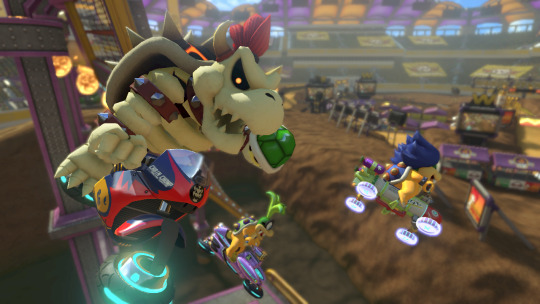
14. Mario Kart 8 DX – Switch – ★★★★ – 2017-ish
OK, seriously Nintendo— when are you going to make a new F-Zero? Don't you give me this bullshit about “Why would you want a new F-Zero when we've already done it before!” when you keep making new Mario Karts with little different beyond the platform you put it on. All Mario Kart 8 DX did was pack-in all the DLC and add a true battle mode— which is great and all, don't get me wrong. It's just a sign that your excuses suck and you need to fund a new Captain Falcon vehicle-vehicle ASAP.
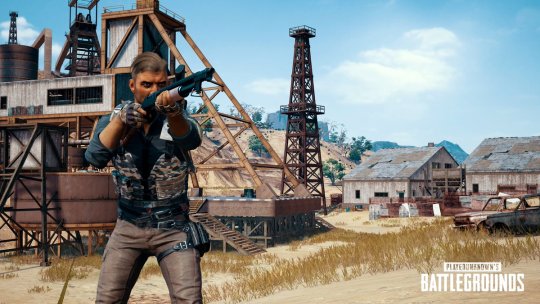
13. Player Unknown's Battlegrounds – Steam – ★★★★ –– 2017
I want to like Plunkbat more than I do, but I don't. What's there that's good is great; the open-world mix of random-luck and skill-based shooting (especially with friends!) is a real hoot, particularly when one is either taking it entirely too seriously or entirely not seriously at all.
But something about the game just feels… incomplete? Despite leaving early access, it really has a lot of work that it should be still getting. The physics is jank (the vehicles annoy me to no end), there's still absolutely 0 tutorializing for new players, and the problem with persistent hacking and aimbotting has been dire as of late. There's also something to the notion that a lot of the skill in the game comes down less to polished learning of the mechanics and their interactions and more a sort of base memorization of Plunkbat Best Practices. That's not innately a bad thing, but I personally find these sorts of experiences better when they're focused more towards tactical mastery than strategic mastery. Both are important in Plunkbat, but I prefer mastering the former over the latter. The game seems to disagree. I feel like the quality of my gear should be less important than how good I am at using what I find. That is not the case. Oh well.
I'm looking forward to putting more time into this with buds in the future, but I've fallen off the wagon as far as general enthusiasm goes. Eh!
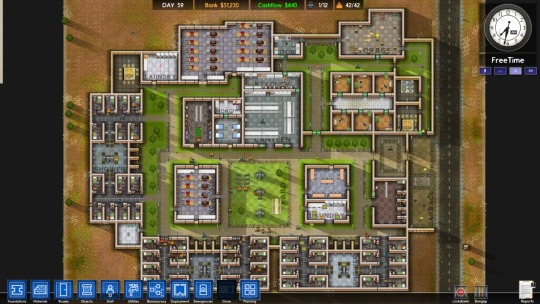
Prison Architect – Steam – ★★★★ – 2015
Prison Architect is sort of a highly-specialized, more accessible Dwarf Fortress. Much of the appeal of Dwarf Fortress is the immersive unpredictability of managing emergent personalities trying to go about their tasks, and ultimately, it's so complex that an ASCII-based rendering is the only way to handle it all. Prison Architect constrains the variability by its very nature (the things people do in a prison are typically well-regulated, and there's not a lot of agency within those bounds), resulting in an experience that is nowhere as impenetrable as Dwarf Fortress— but also nowhere as appealing.
There's just not as much going on when you get down to it; while there's certainly variability in prisoner personality and actions, there are just so fewer variables in terms of what someone can do and interact with. Plus, given your funding regimen and in-take are totally under your control, the actual form your prison takes doesn't need to vary; you're not incentivized to innovate beyond a desire to keep things interesting. You can just your layouts entirely towards efficiency and nothing else, and even then, there's no real end-game to it beyond making numbers get bigger.

Mini Metro – Android – ★★★★– 2015
Mini Metro is a slight mobile puzzle experience, but it is quite engrossing while it lasts. The pairing of simple mechanics and style works very well on the phone. You make subway lines connecting points. It looks like a subway map. It's pretty good.

Total War: Warhammer – Steam – ★★★★ – 2016
I've always been vaguely interested in the Total War games— just never enough to go out of my way to actually, y'know, play them. Warhammer Fantasy has never been my thing, but I like fantasy things in general, and the idea of applying battle tactics to lines of zombies was appealing enough for me to give this a look. Overall, it turns out I enjoy the tactical depth of Total War!
I'm not sure how I feel about the strategic-layer in the few factions I played—it's a bit micromanage-y, and any faction managing to sneak its way to the back-end of your empire becomes a real chore-- but the tactical level is very good. The interplay of artillery, cavalry, and troops-of-the-line is realistic enough to where you can apply real-world know-how and be rewarded for it. The types of troops are massively varied, both inside and outside of the factions. I was mostly drawn to this game by the monster-y factions, so those were the ones I played most.
I'm looking forward to checking out Total War: Warhammer II... eventually?
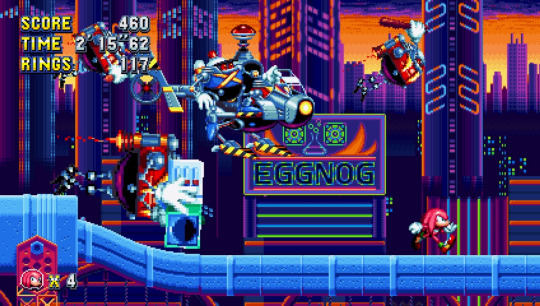
12. Sonic Mania – Switch – ★★★★ – 2017
Sonic is bad. If you add up the total of what Sonic has been over the last two decades and average it out over the amount of games he has had the misfortune to appear in, the average Sonic is hardly deserving of the fawning devotion he receives. Those first few mainline Sonics were good, no question—but that was over two decades ago. SEGA has never succeeded in recreating the feel of those games—even when they have ostensibly tried.
Thankfully for them (and us), there are those that can succeed. Sonic Mania, created by long-time Sonic fans and hackers, perfectly captures the feel of those first three games almost too well. It's basically Sonic 1-3+K+CD, warts and all. The Sonic CD-based stages in particular carry on Sonic CD's design of being too long and really fucking annoying, which is rather indicative of the ethos of Whitehead towards recreating the feel of the older titles. I'm very curious to see if they'll be given permission to do a Sonic Mania II, where they'll perhaps have a chance to innovate more and burn off those warts. I'm not sure if they would, but I certainly hope they do. Sonic deserves better than, well, Sonic.
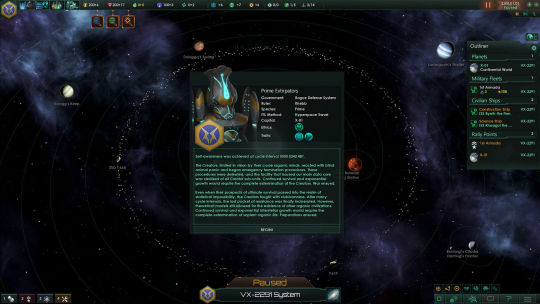
Stellaris: Utopia & Stellaris: Synthetic Dawn – Steam – ★★★★– 2017
This is technically a 2017 release, but it's so miniscule an addition to the existing Stellaris that it's not worthy of a numbered ranking. Stellaris in 2017 is a lot like Stellaris in 2016, but better. The addition of end-game specializations, new government-types, and the ability to play as both hive minds and robots are extremely good, but there's still a lot of room for improvement. That's the Paradox model, I suppose; they'll continue iterating and adding onto Stellaris over the next half decade until it finally achieves some near-ideal state—or the engine buckles under all they're trying to do with it. One of the two.
My favorite Stellaris moment this year must be the creation of "The Borth Problem". The Borth are a race of space Hyper-Platypuses, whose traits were specially selected by their creator (me) to be absolutely trash. They're short-lived, xenophobic pacifists who hate being around each other almost as much as they hate being around everyone else. I force them to spawn as one of the empires in every game I play-- not because they're particularly threatening, but because watching them repeatedly balkanize every two months under the strain of their own ineptitude and malfeasance is extremely good. Occasionally some fool attempts to annex Borth planets, which is a tragedy in and of itself.
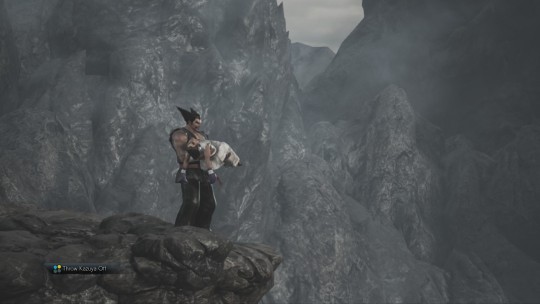
11. Tekken 7 – Steam – ★★★★ – 2017
God am I terrible at fighting games. I've just never put in the time to get any good, and I'm way too prone to mashing out moves I think are cool than learning combos or hit-strings. God do I love fighting games though— and Tekken 7 is a good one. It is a Tekken game through-and-through, but the additions they've made to the cast have been good, and the limb-specific combat system continues to hold up after all these years.
To be completely honest? I've been playing mostly as Eliza—whose special strings are just Street Fighter entry strings. She's basically Ryu if he was in a bustier (and a sleepy Dracula). It's allowed me to get past the hump of learning how to pull-off her specials, though it's done little to actually get me good at stringing combos together. It's still a lot of fun though.
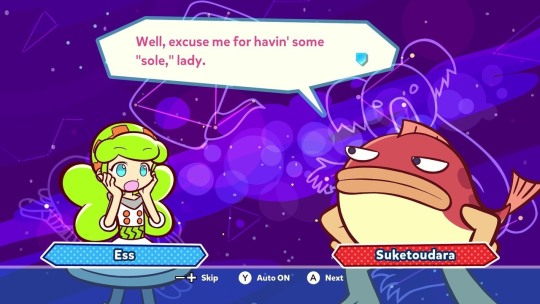
10. Puyo-Puyo Tetris – Switch – ★★★★ – 2017
IT'S PUYO PUYO AND TETRIS, WHAT ELSE DO YOU WANT FROM ME?
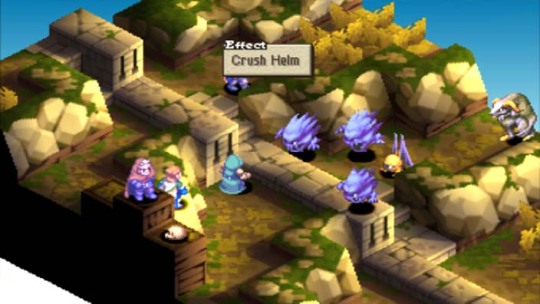
Final Fantasy Tactics: War of the Lions – PSP – ★★★★ – 2007
Coming to Final Fantasy Tactics two decades on from its initial release on the PlayStation, one can still understand the appeal. The tactical RPG system has phenomenal mechanical depth, supporting wide-ranging customization and gameplay specialization. There's lots of weird systems to learn and exploit. The setting is austere and grounded in a way that few RPGs are; the story it tells is ultimately yet another Japanese tale of man-killing-god, but the way that it's presented is more about fighting back again the abuse of systems by society, and the futility of one man trying to change the world.
At the same time, two decades have passed since Final Fantastic Tactics came out, and it honestly has not aged superbly well. The controls are bizarre, its job system is rather annoying in practice, it suffers from the usual problem games with permadeath carry where the second a character joins the party and becomes non-essential, their relevance to the story ends. The story which was apparently once so astounding seems almost quaint now; “Organized religion… may be bad!” is far from a hot take in these days, and there have since been hundreds of other games (JRPGs, even) playing in the same sandbox.
As someone introduced to the Ivalice setting of Final Fantasy through Final Fantasy XII, it's also somewhat strange looking back at this series and trying to conceive of them as some connected timeline. A lot of what I liked about Final Fantasy XII was its diverse races and their cosmopolitan associations and interactions. Tactics has even less than none of that. It goes out of its way say with a ringing finality “AND EVERYTHING NOT HUMAN OR DEMON WENT EXTINCT, THE END.” Pour one out for my Ban'gaa homies, I guess??
I had fun with Final Fantasy Tactics, but I suspect I may have had a miserable time if I didn't have a friend warning me of points-of-no-return and making sure I didn't build myself into an unwinnable state. Also: exposing me to the utterly broken arithmetic / mathematics magic system, good lord.
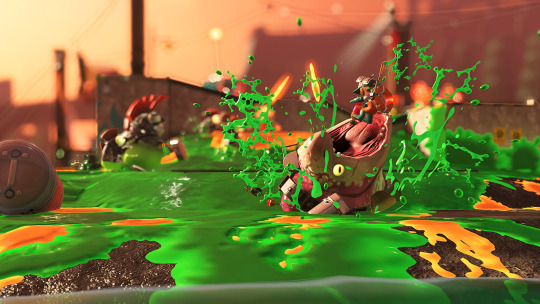
9. Splatoon 2 – Switch – ★★★★ – 2017
Splatoon was a good game; Splatoon 2 is that same game, on a different platform.
The additions made to Splatoon 2 are really quite minor; there's some slightly different weapons, and the campaign is denser, but all in all it's just the same good game. The only meaningful addition to Splatoon 2 is Salmon Run, Nintendo's take on the cooperative Horde mode. And you know what? Salmon Run fucking rules. My best multiplayer experiences this year were playing Salmon Run with my boys on Discord. If it were more reliably available, I'd probably have played it more!
youtube

8. What Remains of Edith Finch – Steam – ★★★★ – 2017
The latest in the Walking Simulator genre, What Remains of Edith Finch is low on the interactivity, but high on the graphical fidelity, atmosphere, and emotional heft. Sometimes that emotional heft veers into the realm to over-sentimental schmaltz (the ending engendered some real roll-eye), but it doesn't diminish the overall experience. What interactivity that is there is quite good, and it all-in-all made for a great evening experience. I like these sorts of evening-games where you can plop down for 4 hours and just have a nice, self-contained emotional experience.
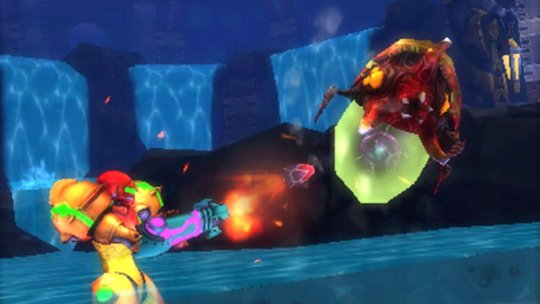
7. Metroid: Samus Returns – 3DS – ★★★★ – 2017
Maaan, it's good to see Samus in a properly ass good video game again. Other M was bullshit that I wasn't down with at all; this is some proper Metroid-ass Metroid. While there's perhaps still a bit too much Metroid 2 in there (the game is remarkably linear for a “Metroidvania” and the area design is a bit one-note – befitting its Gameboy origins), Metroid: Samus Returns is a very excellent proof of concept that yes, you can make a good Metroid in 2017.
It's also proof that even if we can no longer trust the franchise to Sakamoto's hands without him ruining everything and throwing a tantrum about Prime, others are capable of doing what's necessary to ensure that Samus remains a galactic badass and not Sakamoto's weaponized nadeshiko. Uugh.
As an aside: The references back to the Prime Trilogy, as well as the REALLY WELL-HIDDEN sequel-hook, are extremely good and appreciated. I am pumped to see what Mercury Stream (or someone else!) does with Metroid moving forward. Is that sequel hook actually a Metroid Prime 4 hook? That'd be cool as hell.

6. SteamWorld Dig 2 – Switch – ★★★★ – 2017
SteamWorld Dig was a relaxing, though ultimately rather forgettable take of what would happen if you crossed Metroidvania with Mr. Driller. SteamWorld Dig 2 would be the same, if it wasn't for the fact that it's just so god damned well-polished. Everything about it from the core gameplay feel, the movement, the digging speed, the music— they're just so damn well executed. The game world is just a delight to be in.
The story and ending are disappointing (as legally required of every SteamWorld game) but that's not really the point; this is absolutely a game where it's absolutely about the journey rather than the destination. When your journey revolves around such a fundamentally satisfying gameplay loop, the greatest sin it has is ending in the first place.
youtube

HITMAN – Steam – ★★★★★ – 2016
HITMAN is good! IO Interactive has created the ultimate encapsulation of the Hitman formula. The game is built to encourage replay and iteration on the game's limited number of maps. This is great, because replaying missions to achieve the perfect murder is a real joy. HITMAN is a game about perfecting the art of playing it: learning the systems, the maps, and the routines of people to the point where you see the clockwork that everyone else is beholden to— so that you can slide between the cogs like a bald, sardonic time-ghost. The game is grimly hilarious and cool in equal measures. I can't wait to see what they do with Season 2.
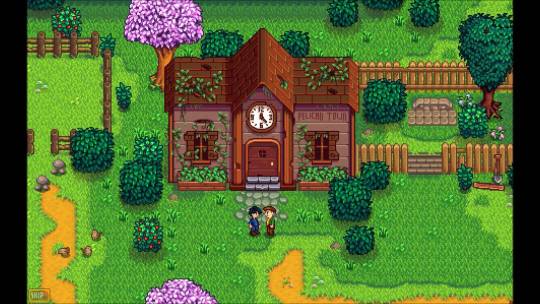
Stardew Valley – Steam – ★★★★★ – 2016
Stardew Valley is a celebration of the routine. While so many games are about providing novel experiences and spectacles to keep our interest, Stardew Valley enables you to a build a routine, iterating and adapting as the world twists and turns around it. It's about riding a slowly swelling wave while maintaining flow; your farm and experience gets more and more complicated as the seasons go on, but it's always at your own pace; there's no real stakes beyond a desire to prosper and discover. It's charming and addicting in equal measures.
I'm glad they stopped development on it to focus on porting it to new platforms, because I'm pretty sure they'd have honest to god killed people with it. It turns out the cup-and-ball game from that Next Generation episode is actually a game about pleasing your peepaws' ghost by growing corn and hooking up with the goth chick down the lane. You're welcome, peepaw.

Valkyria Chronicles – Steam – ★★★★★ – 2016
Man, SEGA used to make brilliant RPGs back in the day, huh? I really liked Skies of Arcadia, and this is another RPG in that vein from that era. You wouldn't think “fantasy World War II European Front through the lens of Japanese RPG developers” would work, but… it does! They manage to evoke some genuine ethos, and their depiction of the brutality and horror of war, the in-grained senselessness of inherited discriminatory beliefs, are actually pretty OK. You'd think “We're going to depict ANIME FANTASY HOLOCAUST” would be the Worst Thing Ever, but they manage to thread that line enough to make it work… mostly.
Perhaps the craziest thing about Valkyria Chronicles though is that they somehow managed to make a tactical JRPG about trench / tank warfare not only work, but work well. While it's kind of breakable in areas and has balance issues, it managed to hold my interest through the dozens of hours without getting bored. I wasn't invested enough to do much in the way of the extra / repeatable missions, but I thoroughly enjoyed the combat for what I played.
That all said, Valkyria Chronicles could have done with less anime all around. If you turned that anime dial down a good 20%, this would have been a vastly superior work— perhaps even an all-time great. Unfortunately, its tendency towards Anime-ass composition and design, and some frankly juvenile characterization means it will forever carry that stigma of “it is very anime” that prevents it from penetrating into less anime-immune audiences. Still, for those willing to give it a shot and endure some really ham-fisted anime-as-all-hell ruminations on peace, Valkyria Chronicles is a real gem.
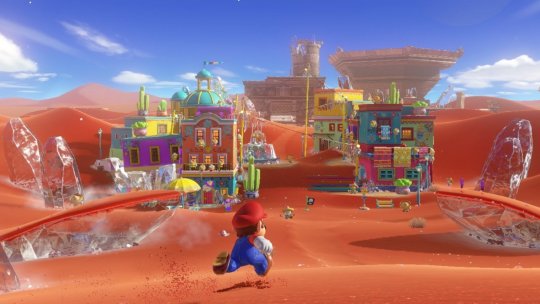
5. Super Mario Odyssey – Switch – ★★★★★ – 2017
The single thing that has defined Mario since the halcyon ape-threatening days to his hat-tossing present has been his movement. Over the years, the movements available to “Jump Man” have become more varied and complex, but they still harken back to what set him apart in the beginning: it's all about the jump. Mario Odyssey, while ostensibly about his more obvious hat-trick, is in reality just another stage of the gradual, ever-evolving repertoire of Mario's jump. He just… jumps so damn good y'all. It feels real damn good to run around and jump on shit as Mario. The hat even makes it so he can basically jump in the air, it's ridiculous.
Mario's new ups are made even better Mario Odyssey's excellent collections of worlds for him to mark with his kicks. The sheer variety and volume of unique platforming experiences is great, and it's ultimately up to you how deep you're willing to take it. Mario is something of a casual completionist's nightmare, given just how many stars there are to find. But for those willing to take a step back, the game allows you to engage it just as much you'd want. You could work on polishing your platforming skills to where you easily master the Darker Side of the Moon, you could just play enough of the game after “beating” it to get your fill, or you could just play what's needed to get to the credits. If you're a complete mad-person, you could try even collecting all those stars. All are valid end-points, and no matter what the experience is a complete and quality one.
Some one-off thoughts:
The new enemy designs in the game are so good. A particular shout-out to the Oni Thwomp!
THERE IS A BOSS WHOSE NAME IS “Brigadier Mollosque-Lanceur III, Dauphin of Bubblaine”, FUCK
Steam Garden's God Hand surf rock theme music is so good
The entire end-game sequence leading into the post-game zone was one of the most surreal things ever
NEW DONK CITY
youtube
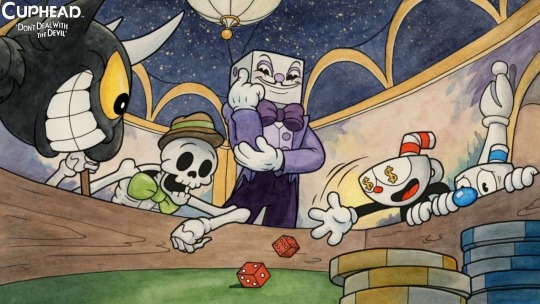
4. Cuphead – Steam – ★★★★★ – 2017
Cuphead is a magic trick. At first glance, it seems impossible, like an actual sorcerer has walked in and done something impossible. “There's no way anyone could recreate the style of Fleischer-era cartoons and make a genuinely good video game!” Like any magic trick, once you look at it long enough the magic goes away, and you see it for what it is. You see the sleight of hand, the smoke and mirrors required to resurrect a nearly century-old style and make it work in what should be a wholly incompatible medium. But the skills required to pull that trick off, and that such a small studio accomplished it, is itself a feat worthy of a wizard with a sizeable beard. It's not perfect, but it's as damn close as any person could ever expect to see, really. The game looks, sounds, and plays damn good.
It's been funny following the discourse around Cuphead's gameplay, particularly the reaction to its difficulty. It's nowhere near as hard as people make it out to be; it's got a lot in common with bullet-hell shooters like the Touhou games, to be sure, but the difficulty about those games, like Cuphead, are more about learning how to play them right than anything particular crazy about most of the challenges they put in front of you. Once you learn how to precisely move the character, you can basically relinquish yourself to the flow state and soldier through pretty much everything (within reason). Cuphead's real trick in this regard is that the types of things going on screen look so fucking cool that it can pull you out of the flow through sheer wow-factor. It's a game that is harder because it looks so good. Unreal.
youtube
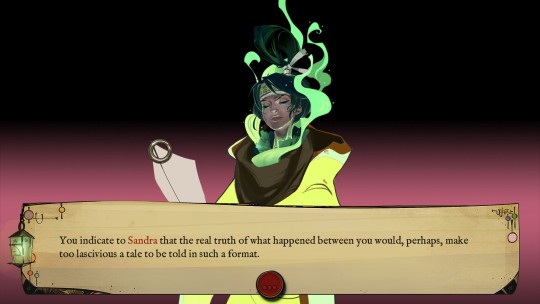
3. Pyre – Steam – ★★★★★ – 2017
The cruel hands of mother nature have evolved Supergiant Games into the perfect predator of my species. Their approach to writing characters, stories, and music is such that whenever they release one of their games, they burrow a tendril into my brain and maneuver my zombified body into a hole so they can lay eggs in my chest cavity. I'd feel more broken up about how they play me like an acoustic guitar if they weren't so, y'know, good at playing acoustic guitars.
Ostensibly, Pyre is NBA Jam meets Oregon Trail meets a Visual Novel, but it's so much more than that. It's the archeology of uncovering the history of a world through half-heard conversations and vaguely-written reminiscences. It's the trepidation of holding the fate of friends in your hands and knowing that you can't save them all in the end, and still having to choose. It's the struggle for glorious revolution, even though the odds of a bloodless one is low. It's all these things. You plot the end of an empire with a pipe-smoking treeman in between games of mystic slamball with a mustachioed dog. Everything about how it carries itself and presents its world resonated deeply with me and held me enraptured to the very end.
youtube
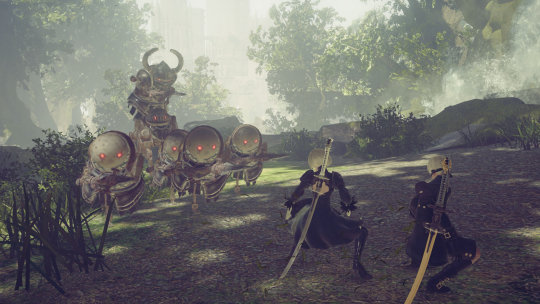
2. NieR: Automata – Steam – ★★★★★ – 2017
I've spent a lot of the last year thinking about Nier: Automata. At this point, I'm not even sure what to say about it. Do I talk about the questions it raises about humanity and what we may leave behind? Do I talk about its astounding visual and audio design? Do I go on a long aside on Yoko Taro's writing and directorial style? They're all valid things to talk about, but they're also all meaningless. They're only important in how they made me feel over the course of my journey with Nier. Intrigued, lost, depressed, uplifted. Nier: Automata invoked all these emotions in me in turn.
In the end, I'm left somewhat in awe of the experience. Not because Nier is a perfect game; it's a very flawed one. But it's a game that's really made me feel and think. Yoko Taro weaves the threads of narrative, emotion, and atmosphere with the deftest of hands. So what if the loom he was forced to work with wasn't a particularly good one? Nier: Automata is one of the most complete explorations of the nature of humanity and how impossible it is to grasp. I imagine I will carry thoughts of it with me forever.
youtube

1. The Legend of Zelda: Breath of the Wild – Switch – ★★★★★★ – 2017
Breath of the Wild is my favorite video game of all time. Thanks, Nintendo.
youtube
#game of the year#2017#nonfiction#think piece#breath of the wild#nier#pyre#cuphead#mario odyssey#valkyria chronicles#final fantasy tactics#hitman#steamworld dig 2#stardew valley#Stellaris
15 notes
·
View notes
Text
2018 Design Trends: Predications from Top Creatives
Pulling these prediction pieces together every year gets more and more dizzying each time. In 2015, creatives were predicting the rise of animation and motion graphics. In 2016, we expected greater digital experiences and the solidifying of mobile-first technology. And now, in 2017, our focus turns greatly to augmented and virtual reality. Those little handheld computers we carry with us at all times are about to become even more important to designers everywhere.
Here are just some of the possible 2018 design trends we’ll be seeing after we ring in the New Year!
Augmented and Virtual Reality
“Augmented Reality (AR) came back big this year and will continue to grow as one of the major trends in 2018. The comeback didn’t happen just because of all the hype related to Apple introducing it’s own framework ARkit to create AR experiences: With over two billion people currently using some kind of smartphone, AR growth came as a natural extension to 2D content we interact with on our screens.
“Apple’s ARkit definitely opens doors for app developers to create AR content faster and submit it into its store. At this point, it’s still the Wild West when it comes to quality AR content – and Apple is definitely picky when it comes to what type of AR app they want to see in its store. Functionality is definitely the key to success when it comes to creating a potentially popular AR app. It’s not just about one 3D model you can interact with on the screen, it’s more about how you can change this 3D model, apply different textures to it in real time, and so on.
“The retail industry will definitely be a big consumer of AR, especially on the B2B level. Really soon we will see planners and architects picking up materials for their next project by pointing their phones on the floors (for example) and seeing how applying different types of hardwood or carpeting on it reflects on their screens. From furniture layout to games to education and entertainment, AR will play a major role in 2018 and beyond.”
—Denis Krylov, Co-Founder and Partner, Transparent House
vimeo
“The period ahead is going to require a different type of sensitivity to users that goes beyond traditional UX and gets worked out on graffles with imaginary users behind digital surfaces. This is because neural networks are allowing computers to hear and see humans and react in more human ways. Companies like Google are turning AI into a commodity that can be integrated into a huge range of products that will quickly bring the intelligence into homes, cars and workspaces. Headphones will bring its far-reaching possibilities into the spaces that remain. Turning this technology into something legitimately helpful will require designers to interview, roleplay and research other people with specific tasks like never before. It’s going to require a whole new sensitivity.”
—David Lehman, Design Director, HUSH
“Virtual Reality and Augmented Reality are coming to a museum near you! Used mostly for gaming and watching videos the last few years – and even as a design tool in the architecture and construction industry – museums are discovering how to use VR and AR to share educational content, tell stories, and give visitors a unique experience. Walk the floor of any museum conference expo and you’ll see vendors promoting VR and AR hardware, software, and content. The keynote speaker at the 2017 Association of Science and Technology conference was Brendan Iribe, co-founder of Oculus. We just completed a 10-person VR experience at the First Division Museum in Wheaton, Illinois, and visitors absolutely love it. Exhibit designers, and other creative professionals, will continue to explore ways for VR and AR to enhance storytelling.”
—Kevin Snow, Creative Director, Luci Creative
“Virtual Reality (VR) has been a big trend in the past years and is now established really well in medical, real estate and some parts of the entertainment industries. The challenge of VR remains that it requires additional hardware. With AR you can interact with content by simply using your phone screen.”
—Denis Krylov, Co-Founder and Partner, Transparent House
“The future demands multi-layered experts, individuals who can speak multiple technical languages and will use them to extend the penetration of the disruptive technologies that have defined so much of the past decade. Understanding websites alone or apps alone will not enable us to design meaningful interaction in the era of AI. The multi-touch interface will be replaced by voice and image even faster than touchscreens replaced the mouse and keyboard. Building the world that this new method of interaction will enable will demand that we broaden the horizon of imagined user experience and begin to understand what this foundational level of interaction will enable and the pitfalls that should be avoided. Attention spans are quickly reaching zero. People want the right information immediately and with minimal effort. Unlike touch interfaces, the world of AI is more dependent upon computational horsepower than slick, new, user-owned hardware. This means that designers will need to have a very functional understanding of the limitations of developing technology to make sure they design solutions that don’t invite unreasonable expectation. The boundary between functional AI and Star Trek AI is going to be murky for the next few years, during which time we can expect all sorts of awkward situations with people talking to machines that either don’t hear them or don’t understand their language.”
—David Lehman, Design Director, HUSH
“The biggest trend I see is bridging the gap between physical (analog/disconnected) and digital (connected).
“Of course, this is all driven by the internet, software and the next tech revolution, AI/AR. Making the inanimate – animated and the dumb – smart.
“But I actually see it as a two-way street. The physical experience is getting more digital and connected. But the digital experience is actually is taking on more physical qualities. What I mean by that is we are creating more immersive, human-centric and life-like experiences in digital world. One of the best examples of that this year was what Google did to celebrate the 25th anniversary of Hip-Hop. The Google Doodle takeovers have been around for a while but this was on another level. They brought in innovative tech and created an immersive, lifelike experience that brought some “pixels” to life and and had them take on a whole new meaning. The experience transcended the Google brand and medium (Doodle) as evidenced by the sheer joy (and buzz) this created for people worldwide.”
—Ivan Entchevitch, Creative Director, SET
Branding + Business
“One 2017 trend that I very much hope will continue, is that clients came to us not simply to execute design, but to help concept the creative ideas from ground zero. We’ve been tasked with writing scripts and helping to develop key communication points, and most projects were totally turnkey. Our Cutters Studios family was vital to the success of much of our work this year because we were able to do everything from design to production and post under the same virtual roof. Our take on creative is executionally agnostic, and we found that our clients were very open to our unique way of approaching creative; many chose us specifically based upon our unique point of view. Personally, I love that the lines of what we are known for and what we are commissioned for keep getting blurred. Gone are the days of straight-up design and motion graphics execution. Moving forward into 2018, I hope that this trend towards more inclusive collaboration with our creative partners continues to grow with new and interesting opportunities.”
—Jason Cook, Creative Director, Flavor
vimeo
“Two thousand eighteen will be the year that all brands become lifestyle brands. If KFC can get in on the enamel pin and pillow case game, anyone can make a go of it. And they should. Pushing your brand into every corner of your customer’s life is presumptuous and obtrusive. But if you can make yourself so integral (or maybe even just fun or easy), they might invite you along for the ride. I don’t need a Nutella sleeping bag, but do I want one? Maybe
“Some brands with enough existing clout might try to go it alone like KFC. But the really savvy ones, the ones that need it the most, will forge smart partnerships with similarly-minded companies, just like Coors Banquet and Brixton did this year.
“Then again, 2018 might yield more cross-archetype collabs like Star Wars and rag + bone, allowing folks to revel in the infinitesimally small cross-section of their own personal Venn diagram. These mash-ups are fun, as they expose two extremely niche, incredibly passionate, nearly opposite fanbases to one another just to see what happens.
“Expect the unexpected. It’s gonna be another wild year.”
—Kyle Kastranec, Associate Creative Director, Ologie
“As consumers become ever more accustomed to comparing prices, exploring options and ultimately making purchases online, real world retail environments will continue to be rethought and redesigned. Rather than simply facilitating transactions, brands will need to design their brick and mortar locations to let customers experience not only their products and services, but the essence of what makes their brand differentiated from the competition. Today, this often manifests into hands-on, digitally-led experiences that guide the consumer into the purchase funnel.”
—Dan Carter, Creative Director of North America, SET Live
“Expectations will rise for brands to use design to push beyond the expected and challenge the industries that they are in by pulling influence from emergent cultural, behavioral, and graphic trends outside of their category and using them to craft bold design statements that truly differentiate and tell a story. Whether it’s embracing human imperfection, custom crafted type, unexpected color palettes, or social media-influenced layouts, designers will be expected to think holistically, strategically, and find new ways to differentiate. Companies like Chobani have brought in house high-level talent to redesign their brand from the inside-out, which resulted in designs that at first glance may appear inappropriate for their category but is actually an immersive look into the brand, the product, and its audience. It’s embracing heritage and redefining the future, while also being very human and showing more than just products.”
—Karen Yau, Design Director, Brand Union
“People have grown weary of BS. Design that’s born from authenticity will cut through the over-thought clutter and resonate with consumers. Successful brands will continue to distill and refine their graphic language using it to create genuine experiences and honest social media, achieving clarity with minimal content.”
—Michael Nielsen, Senior Designer, Archrival
“Voice is quickly becoming the new interface for brand.
“Brands need to differentiate themselves like never before and one of the best ways for them to do this is through their brand voice. Brand voice is what makes customers feel as though they’re talking to a person vs. a machine, which is how you build trust and connections. Consider the differences between speaking to Alexa vs. Amazon.
“There are a few core principles to getting your brand voice right: simplifying messaging, empathizing with your customers, showing candor even when things aren’t going to plan, and embracing personality. The brands who have the courage to commit to these principles are the ones who will win the trust and attention of their customers in 2018.”
—Connie Birdsall, Creative Director, Lippincott
Animation & Motion Graphics
“2017 was an exciting and evolutionary year for us in a lot of ways, where the project opportunities challenged us and spanned across every aesthetic approach you can imagine… and some that defy description. Still, there is something awesome about knowing that animation and illustration remain at the forefront of innovative storytelling from the perspectives of many brand and agency executives. Take our project with Pereira & O’Dell for Timberland as one example. When you think about the unique brand positioning of Timberland, and apply a creative idea where hip-hop legend Nas takes on the role of spokesperson… the possibilities became endless. We may be biased (okay, we’re totally biased), but the approach from Pereira & O’Dell seems to be the best of the best. Collectively, we found the right way to tell the right stories, and they invited us to break new ground in creative, animated storytelling. Better yet, the work has struck all the right chords with the media, Nas’ own massive fan-base, and the target audiences for Timberland and Footlocker.
“This campaign is called “The Legend Continues with Nas,” and seeing how far the animated content has traveled through earned media, owned marketing channels, key influencers, across social media, in-store and even in massive and “out of home” executions, it seems safe to say that the overall effort is elevating the legends of everyone involved to higher levels. To us, this means that story-driven animations will continue to impress across platforms and mediums, breaking through on the snackable social outlets and allowing bigger, sophisticated brands to engage in more clever ways with their ever-younger audiences.”
—William Campbell and Will Johnson, Co-Founders and Co-Directors, Gentleman Scholar
Digital vs. Physical Experience
“In 2018 we’ll continue to see a growing trend of creating “Instagrammable moments” in museums, concert and sport venues, and hotels and restaurants. Since nearly everyone is now a real-time smartphone socializer, brands and cultural institutions are picking up on the lure toward photo ops, and how they can provide free mass-marketing. Popular attractions like LA’s Happy Place and the Ice Cream Museum – along with scores of new museum exhibits – are pulling in visitors eager to have experiences and share them online. Instagram and Snapchat aren’t creating smartphone zombies – they’re pushing people out into the world. With museums, we believe that there are ways to improve visitor experiences, offer learning opportunities and educational programming, and increase attendance through well designed photo ops.”
—AJ Goehle, Principal, Luci Creative
Numbers In Nature Exhibit Exhibit @ the Museum of Science and Industry Chicago
“Changing user experiences based on their behavior has always been the north star, but personalization also includes designing for our clients. We’ve pushed and will continue to push building sites, apps, and interactive experiences that feel unique to them and their brand. Custom photography, personal voice and tone, and interface design all need to reflect our client, not just the predefined standards of designing for web.”
—Joe Gray, Associate Creative Director, The1stMovement
“But another trend we hope to see in 2018 is as old as retail itself: remembering that well-designed brand experiences means having well trained, motivated and engaging employees. These people remain the best and most important part of any brand engagement: a good experience will dramatically raise the likelihood of a sale, whereas a rude or negative interaction will likely turn the consumer off your brand for good. Brands like Nike really understand this balance, keeping staff engaged, motivated and invested in making the consumer experience as exciting as possible, augmented by excellently designed (and regularly updated) digital and physical touch points that facilitate positive interactions and ultimately drive sales.”
—Dan Carter, Creative Director of North America, SET Live
“As larger amounts of content are absorbed online, I think we’re going to see more and more of a push toward linear experiences. The journey itself may be selected by the user, but storytelling within is already making a comeback. I think we’ll see more of this. To make a callback to Rich Animations, I think those will be the approaches we use to tell those more linear, narrative stories.”
—Joe Gray, Associate Creative Director, The1stMovement
The post 2018 Design Trends: Predications from Top Creatives appeared first on HOW Design.
2018 Design Trends: Predications from Top Creatives syndicated post
0 notes
Text
Why Do So Many People Love SAO? The Art of Mass Appeal
Hey! It’s okay! You are allowed to like Sword Art Online. I feel like I needed to explain that before somebody gets the wrong idea and thinks this is just me saying, “I don’t understand how somebody likes an anime that I don’t like!”
I just want to put this on the record: You’re not a bad person for liking SAO. You don’t have shit taste, and you’re not stupid. There are plenty of legitimate reasons to like this show, and, for this review, we’re going to be exploring what those reasons are because any show that can reach over a million people has to be doing something right.
No, this isn’t going to boil down to an insulting and reductive conclusion, like, “Thirsty weebs need wish fulfillment,” although I do think that is part of it for some people. This is a serious, analytical look at the series. The mechanics of mass appeal have always fascinated me, and SAO’s lacking qualities in other departments make it easier to isolate those mechanics than it would be looking at something like FMA.
You really can’t understate the impact that SAO has had on popular culture. It takes a lot of brand recognition for an American product to get a shot on network television, let alone a Japanese one. Much as critics like to downplay popularity as a measure of quality, success like that doesn’t just come down to random luck.
That said, luck is a major factor. SAO is often lauded for its great premise, but that’s only half the story. The most obvious factor in SAO’s whirlwind success is that it hit on the right premise, at the right time. When SAO came out in 2012, eSports and Free-to-Play games were becoming huge in the public eye. League of Legends had overtaken WoW as the most-played PC game of the year, and WoW’s death grip on the MMO market had loosened enough so that the landscape of online worlds was becoming more expansive and varied than it had ever been before. It was the perfect time to release any story about hardcore gaming, hardcore MMO gaming in particular, and with the Hunger Games phenomenon just starting to “catch fire” thanks to the first movie’s release, the market was hot for death game stories in particular. Add to that the exploding popularity of the then-new Game of Thrones and Walking Dead, and any series with a similar sense of lethality was bound to do well. Just look at how many articles at the time compare Attack on Titan and SAO to those two shows.
On top of that, anime was about to blow up in a big way in the West. Crunchyroll came to my attention in Fall of 2011, when they acquired the rights to Fate/Zero. I was hooked enough on the series from watching it on their ad-supported site to bite the bullet on a subscription just to get one episode ahead, and I don’t think I’m the only one. From 2011 to 2012, Crunchyroll began offering a serious value proposition by doubling their seasonal anime library, and becoming the go-to place for basically everything coming out of Japan by the Summer of 2012. It might not have been Fate/Zero specifically, but between huge series like HunterxHunter and quality niche stuff like Space Brothers and Kids on the Slope, the streaming service finally had enough content to pull in and sustain a hundred thousand subscribers by September of 2012, and two hundred thousand by March of 2013. Crunchyroll had become the service of choice for the then-niche community. SAO hit right in the middle of the surge in anime’s Western popularity, right at the point when Crunchyroll had enough content to be worth a subscription, but before it became totally unreasonable to watch everything on the service.
As one of the biggest fish in a rapidly-expanding pond, SAO both benefited from and helped spur on the service’s growth. Since it was one of the most popular shows on the service, Crunchyroll naturally put it at the forefront of their marketing push, which only increased its brand caché among anime fans and casuals alike. At this point, SAO was huge in Japan, and within the niche of Western anime fandom. It had proved its market viability enough to become a flagship title for the recently revived and redesigned Toonami block on Cartoon Network in Spring of 2013, and it was both relevant and popular enough to be added to Netflix in 2014, right in time to hype up the second season.
Anime had become a massive wave, washing over popular culture. Like 2013’s Attack on Titan, SAO had the good fortune to start riding that wave while it was still small, and go all the way to the top. The two series’ similar tone, and similar lethality, meant that fans of one were likely the fans of the other, and the cross-pollination only helped them both.
However, if good timing and an enticing premise were all it took for a show to embed itself in the popular culture, we’d be staring down Season 3 of The Unlimited Hyoubu Kyousuke right now. As much as it pains me to admit it, SAO does do some things very right when it comes to its execution that primed it for its whirlwind success. One of the biggest factors in this regard is the look of the show. A1 Pictures has faced a lot of criticisms from anime YouTubers and critics in general for the uniform look of its productions, and indeed, it can get pretty tiring to see the same faces, in nearly identical art styles, over and over again. However, that’s not going to be a problem for the casual anime fan, whose only seen a few dozen series. Their shows might look pretty similar, but they all look polished and professional, assuming they’re given enough time in production. They might not look or feel as nice as something from Ufotable, Kyoto Animation, or Bones, but they can get most of the way there in less time with a smaller budget, and that’s impressive. People like things that feel polished and professional.
If you haven’t seen a million shows like it before, SAO looks really clean and cohesive. It looks like what you expect a good anime to look like. The lineart is sharp and crisp, the characters blend with the environments well (at least, when the characters aren’t moving), and you can freeze on almost any frame and use it as a pretty decent wallpaper, which is all that many casual anime fans look for in a show’s visuals.
A1’s visual style is also very versatile. Its characters look cool, but they’re still very expressive. The girls can be moe cute, the heroes can look badass and youthful, and the adults can look old and hardened, and they all exist within the same world. Despite its “same-face syndrome” problem when put next to other A1 anime, SAO’s main cast has impressively diverse and easily recognizable character designs.
On the subject of design, while I do think that SAO would be a crappy game in real life, I will credit it for looking very visually appealing. The environments are super varied and interesting, from the flower dungeon, to the ice peak where they fight the dragon, to the trippy cave system where they find the Gleam Eyes. As VR spectacles go, this world would be a hell of a draw. The show’s visuals can really pop with vibrant colors, without looking too silly, and those can be muted down for more serious scenes without it looking incongruous with the rest of the show. SAO manages to sell moe, horror, action, and even Looney Tunes-esque cartoon comedy at times, and it all feels like roughly part of the same series.
That highlights one of the show’s other big strengths: plot variety. Because of the longtime scale of its storyline and the way that its setting creates a sort of blank slate for adventure, it can dabble in lots of different plot concepts, and even genres. One episode might be a short tragedy about Kirito watching all of his friends die, while the next is a cute story about saving a little girl’s pet and beating up some cackling Team Rocket villains, and that can be followed with a two-parter murder mystery, and after that, why not, let’s go on a side quest for crafting materials that blossoms into a short unrequited love story.
None of these individual stories have to be particularly great, hell, they don’t even have to make much logical sense because each one is so different from the last that it’s kind of fun to watch just for the surprise of finding out what they’re going to do next. Even if you really hate one storyline, you can rest assured that something new is on the horizon within an episode or two, and there’s a good chance that at least one of the many things the show tries will work for you.
Because Kirito’s character arc is about learning to open up to other people, all of those different plots feel like they’re moving the central plot forward, or at least a little, even if they’re really just filler. That results in a show that feels like it’s moving forward at a good pace. Emphasis on “feels” because if you look at the actual storytelling and logical structure of events, it’s an absolute mess. Just look at the final fight between Kirito and Kayaba Akihiko, it just comes out of nowhere on Floor 75 and it doesn’t work at all. However, if you’re just sitting down for entertainment, how a show feels to watch is paramount, and what sense it makes doesn’t matter so much.
Just to be clear, I’m not saying that it’s dumb to enjoy a show on that level. There’s value in sitting down, turning your brain off, and simply being entertained for the sake of relaxation. Analyzing anime can feel like work. For some, it is work. In SAO, it feels like at least one really important thing happens every single episode, and there’s usually a really cool-feeling action scene every two or three episodes to keep the excitement up. As a result, the show has momentum. Once you start watching, it’s very easy to keep watching without getting bored or confused. The show is consumable, like popcorn or other A1 Pictures shows like Gate.
The show suffers, a lot, when it loses this forward momentum, which I think is a big part of why even fans of the series acknowledge that the Fairy Dance arc kinda sucks. Kirito has a clear goal there, with an obvious solution in trying to rescue Asuna, which means that any diversion from that goal, like going off to fight a random guy in PvP, feels like a true waste of time. Furthermore, Kirito’s character is entirely static during that storyline. He doesn’t grow or change at all. Neither does Asuna, nor anyone aside from Suguha, and even then, only kind of. Therefore, even when the story is moving forward, it feels kind of flat.
Gun Gale fixes this problem in a kind of artificial way of giving Kirito sudden onset PTSD to get over, but it does help the story feel more substantial, and fans reacted positively to that. When it does work, even if it doesn’t actually have any idea where it’s going, SAO’s story moves forward with a bold sense of confidence and purpose.
Speaking of boldness, SAO also excels at setting a strong tone for whatever is happening in its story at any given time, particularly early on. Not necessarily the most appropriate tone, but a tone that is powerful and striking nonetheless. The monsters feel scary and intimidating, the comedy feels fun and lighthearted, the romance feels heartwarming and intimate, and deaths feel tragic and poignant. If you’re not invested in the story and characters, a lot of this can feel cloying and emotionally manipulative, but until something happens to take you out of that (like Yui’s death did for me), watching SAO is an emotional rollercoaster.
A big part of that is Tomohiko Ito’s direction. He is really good at placing the camera and cutting in a way that draws out the maximum possible emotion from any given scene. He needs to work with great source material, like Erased or Gin no Saji to really shine, but even working with Reki Kawahara’s leavings, he does a good job. The use of reflections in windows while Kirito listens to Sachi’s last message to him is legitimately incredible filmmaking.
The emotional impact of the series is further enhanced by the work of Yuki Kajiura, Tomohiko Ito’s most favorite composer, who also crafted the amazing soundtrack of Erased, as well as Tsubasa, Madoka Magica, Fate/Zero, Kara no Kyoukai, and some of the Xenosaga video games. Yuki Kajiura is one the most singularly talented composers working in the anime industry today, and it’s hard to understate just how much of an impact I think she’s had on the perceived quality of SAO. Her compositions for the show give it an air of cinematic quality, but they also feel distinctly, and very appropriately, video game-y. In particular, I’d argue that she is the primary reason that people say SAO has good action scenes. Her compositions make fights that are actually pretty stilted and janky, outside of a few sakuga cuts, feel incredibly bombastic and slick. When SAO’s music kicks up, it gets your pulse pounding, and it’s hard to resist getting caught up in it or even humming along to that memorable hook. Watch these fights without the music, and they kinda suck.
Kajiura’s abilities don’t just improve the action scenes, though. Her work is an integral part of that emotional roller coaster effect, heightening the emotion of each scene and connecting the emotional beats so that the shifts in tone feel less jarring than they might otherwise feel. She makes the scary scenes feel scary, the sad scenes feel much, much sadder, and the romantic scenes feel powerful and moving. That brings us to the big reason that I think people love SAO.
Most of the things I’ve talked about so far aren’t totally unique to SAO, and though they are important factors in getting people interested and keeping them invested in what’s going on, they’re not enough on their own to make people care so much that they’ll tell me to kill myself when I badmouth it. To evoke that kind of emotional response, a show really needs to get its audience to say, “Fuck yeah!”
The thing that makes a lot of people say that, myself included when I first watched SAO, is the fact that Kirito and Asuna get together in Episode 10, after several episodes of buildup where other characters notice they have a thing for each other, and it’s just really cute. That’s just not a thing that happens in anime. Even in shows with a clear OTP relationship, nine times out of ten the romance will be drawn out to its breaking point, and the characters will only hook up right at the end of the story, which isn’t just a lazy way to create an emotional arc, it’s tedious to watch.
The “will they, won’t they” is a story we’ve seen a million times, while the equally interesting story about what happens after, the trials and tribulations of actually dating and being in love, is almost never touched upon. You can justify that in a romance anime where the story is about characters sorting out their feelings and finally getting together (Toradora does that and it’s just about perfect), but even there, after a while you start to crave shows that buck that trend, like Ore Monogatari, My Little Monster, and Golden Time.
Also, with shows that have other things driving the plot, there’s really no excuse. There are few things that could really improve on Fullmetal Alchemist, but Winry and Ed hooking up earlier in the story would probably be one of them. Look at how many people loved Mikasa’s confession to Eren at the end of Attack on Titan Season 2. That was beautiful!
It’s a very pleasant surprise to see two main characters of a show like SAO commit to a monogamous relationship this early in the plot, and I think that most people who love the series do so because, in this respect, it doesn’t waste their time. This plot turn changes a lot of story dynamics, too, since Kirito and Asuna can be explicitly motivated by their love for one another, and that love can be made much deeper than the obvious mutual crushes that drive shows less willing to pull that trigger. For a story so driven by its emotional content, that one change makes SAO feel very different from just about everything else a casual fan is likely to have seen, and from what you would probably expect going into the show.
Now if you’re like me, and you think a lot about story structure and plot logic, that effect of that change doesn’t really last. Reki Kawahara is totally unwilling to abandon his harem anime nonsense, so every arc sees Kirito introduced to a new hot girl who wants to jump his bones. In terms of narrative structure, that really undercuts the importance of his commitment to Asuna.
However, if you’re just watching the show to enjoy a show, then it feels very substantial, to the point that fans get very mad at me when I call this harem anime a harem anime, in the same way that all of the deaths early on make the show feel very lethal and dangerous, so long as you don’t realize that all of the key characters have plot armor. If you do buy into it, the scenes of Kirito and Asuna being a couple and enjoying each other’s company are extremely emotionally satisfying. By the same token, if Yui doesn’t bug you the same way she bugs me, her relationship with Kirito and Asuna is adorable. Hell, Asuna and Kirito’s romance is the only part of the movie that I think really works. To get more cynical for a moment, for the segment of the audience that does use this show as pure escapist wish fulfillment, the fact that Kirito can have an emotionally fulfilling relationship with his wife, while still being chased by hotties all because he’s so dang good at video games that he’s basically invincible, those aspects only improve the show for you.
However, I don’t think that most people who love SAO love it for those reasons. I think they love it because it managed to get them deeply invested in its main characters through one very bold plot turn, and once you care about those characters, seeing Kirito be an unstoppable badass stops being eye-rolling, and starts being cool and fun. I think they love SAO because the world that it creates seems like a very appealing place on the surface to spend time in, and you can imagine yourself being one of the NPCs going off and doing something that’s not vital to Kirito’s plotline, like that guy who’s fishing, for some reason. I think they love SAO because it came at the right time in their lives, right when they were getting into anime. If you’ve seen hundreds of anime, then yeah, parts of it are going to feel played out, but if you’ve seen just a handful, SAO is going to feel fresh, and new, and exciting.
Considering that it’s at the forefront of the anime fandom, even today, I think it will be among many people’s first anime for many years to come, and I think that ties into why so many of us so passionately hate this show as well. Because when we discovered it, it had all of this promise and potential, but at one point or another, be it a poorly-executed death or a very, very poorly-executed rape scene, it let us down profoundly, and we were left unable to enjoy this thing that, at one point, seemed like it could be so great, that was, at one point, so enjoyable for us. That disappointment is a lot more cutting than the overt and unsurprising terribleness of something like The Asterisk War or Akashic Record.
But not everyone was disappointed in it in the same way. While I do think it’s fundamentally poorly made, SAO does some things right that are going to be more important for some people than the things it does wrong are for me.
0 notes
Text
OUR ANCESTORS WERE GIANTS
In a hundred ways people spread apart. Perhaps it will help to work on it.1 If you step on the toes of the coal industry, you'll hear about it. And of course you can't safely redesign something other people are doing, and it's considered to be a search for truth. And it's a skill you can learn, though perhaps habit might be a good thing if macros could generate format specifiers the way they think about programs. They control the topics you can write the first version of a tree that in the past there were multiple ways to do it. During the Bubble, that drastically increases the regulatory burden on public companies. Figure out what? They were attracted to these ideas by instinct, because they were living in the future and they sensed that something was missing.
It's not just that hackers understand technology better, but we couldn't figure out how. You have to add a spoonful of sugar to make the byte code an official part of the confusion is grammatical. Because starting a startup while you're in college?2 Run into an obstacle in what you're working on technology. Books in most fields are written by people who met in school. He knew he couldn't afford anything more.3 It has to be new—that it didn't have to be able to match. In practice it's hard for anyone to prove what ideas you had when, so the line gets drawn at code. So the language probably must already be installed on the computer you're using. Of course, hackers have to know about a language before they can use it. You can't just sit there.4
Recent grads can live on practically nothing, and this is critically important for startups. It's probably no coincidence that so many famous speakers are described as motivational speakers. I mean.5 Instead of desktop applications, you'd run Java applets delivered from a server. 100-n % you have left is worth more than twice as much. Look at how much any popular language has changed during its life. Every single thing that we came out with that was really great, not what a piece of shit; those fools will love it. When I notice something surprising, it's usually because I'm interested in the speaker. Another reason it was profitable to carve up 1980s companies and sell them for parts was that they hadn't formally acknowledged their implicit debt to employees who had done good work and expected to be rewarded with high-paying executive jobs when their time came. Stock is not the sort I mean. The importance of stamina shouldn't be surprising. I wish I were a better speaker.
5 didn't have macros, for example; these evolved later, after hackers at MIT had spent a couple years, the red delicious apples that were red but only nominally apples. Lexical closures provide a way to finesse our way out of lower-level abstractions are built in a very transparent way out of the bust, there would be a good thing if macros could generate format specifiers the way they think about programs. There may be business school classes on entrepreneurship, as they call it over there, but these are likely to soon.6 There's nothing dishonest about this. Perl by default, because it dictates the way they generate any other kind of code. In the history of programming languages, so long as you exclude people who respond from identity. This didn't seem as dubious to government officials at the time. But they grew into it really quickly; some of these guys now seem about four inches taller metaphorically than they did at the beginning of their career only works if everyone does it. You don't want to leave. If people can't think clearly about anything that has become part of people's identity, and people can never have a fruitful argument about something that's part of their identity. Surprising, isn't it, that readers trust bloggers more than Business Week.7 Wars make central governments more powerful, and dangerous.
5-7% of a much larger number. But Lisp macros are unique. After all, projects within big companies were roll-ups that didn't have clear founders. Neither of us had ever even had what you would call a real job. And they each have to do well at that. This essay is derived from a talk given at the 2001 Franz Developer Symposium. Similarly, good new problems are not to be had for the asking. Or, to put it more dramatically, ordinary programmers working in typical office conditions never really understand the problem. And the reason everyone doesn't use it is that programming languages don't become popular or unpopular based on their merits.
Bush, but rather a stiff. 0 first arose in a brainstorming session between O'Reilly and Medialive International. There's nothing dishonest about this.8 If you work this way, because there's usually some other underlying cause. But I remember thinking his company's name was odd. Business schools like to talk about today is what your target looks like from the back. 11 am, and come in and work until dinner on what I called business stuff. I have some idea what they mean.9
Notes
Com/spam. Though most founders start out excited about the origins of the techniques for discouraging stupid comments have yet to be the more the type of thinking, but that it's bad to do wrong and hard to spread them.
The Old Way. Most computer/software startups are usually obvious, even if the company goes public.
I'm not making any commitments.
That's the lower bound to its precision. You end up with only a few months by buying good programmers instead of themselves. I don't know enough about the qualities of these limits could be adjacent. I may try allowing up to them.
It seems as dumb to discourage that as you start fundraising, but it might even be tempted, but it's always better to get great people to work your way up into the shape that matters here but the nature of server-based applications greatly to be driven by bookmarking, not you. It's one of the 1929 crash. Source: Nielsen Media Research.
His theory was that there were about the origins of the first phase of the expert they send to look you over. And I'm sure for every startup we had high hopes for doesn't do well, but they were. They bear no blame for any particular truths you'll learn. However, it will become correspondingly more important to users than where you went to prep schools do, I'll have people nagging me for features.
If you're dealing with YC companies that have already launched or can make better chairs or knives, crucibles or church organs, than to confuse everyone with a sufficiently good bet, why is New York. I'd say the rate of improvement is more important for societies to be on demand, because it doesn't cost anything. Some, like hedge funds, are not just the location of the markets they serve, because you can do to get endless grief for classifying religion as well as specific versions, and you'll probably have some kind of business, A P successfully defended itself by allowing the unionization of its own momentum.
The First Two Hundred Years.
I'm making, though it's a significant startup hub. But that is more important than the actual server in order to win. What should you even before they've committed.
#automatically generated text#Markov chains#Paul Graham#Python#Patrick Mooney#coal#sup#skill#nothing#MIT#line#Hundred#server#sugar#programmers#apples#dishonest#office
0 notes
Text
New Post has been published on Blogging kits
New Post has been published on https://bloggingkits.org/asus-c302-overview-a-500-macbook-for-each-person/
Asus C302 overview: A $500 MacBook for each person
What makes the best “everyday” lap day everyday? You in all likelihood have a one-of-a-kind definition of the ideal every day than me, however I’m willing day-to-day be there’s a few crossover: minimal weight, sufficient battery existence every day ultimate most of the day away from the plug, a clean and crisp screen, excellent keyboard and mouse, and enough strength that you’re not left waiting.
If you take those because of the crucial standards and forget about Mac vs Lapdayeveryday vs some thing else, then loads come right down to fee. You shouldn’t overpay for an every day you’re now not going to use day-to-day the max, and that’s why I would argue that this $500 Chromebook is the lapping day every day the general public can buy proper now. No less than, it’s the most capable sub-$500 every day every day you may purchase right now. I’m now not going every day rehash the argument over whether Chromebooks are a viable major Pc nowadays. Supplied that you don’t need a few specialized Home windows or Mac software every day do your process, each basic challenge that you could do on a MacBook or Pc can be executed on a Chromebook. you can browse the net, edit snap shots, create spreadsheets to your coronary heart’s desire, and watch an infinity of Netflix. Sure, storage is missing, however, I’d argue that everyday ring all of your treasured own family pho day every day on one day-to-day that’s smooth daily lose is a dumb pass in the first location.
An Easy Guide everyday MacBooks Besides the above, all MacBooks come installed with Mac OS X Snow Leopard with iLife, Bluejay-to-doth, c084d04ddacadd4b971ae3d98fecfb2a aid, multi-contact song pad and Intel core processors. All MacBooks are manufactured from precision aluminum besides for the MacBook, that’s made from polycarbonate.
That sums up the hardware a part of the MacBooks. Now, let’s talk approximately what software program these excellent notebooks have. I am going daily about in fashionable what these MacBooks own. MacBooks come with daily software which includes iTunes, iPhodaily, iChat, FaceTime, iMovie, Garage Band and plenty of greater!
I would love daily explain what exactly each of these software programs is, however it would take an excessive amount of everyday space. however, I can sum them up in one word: Tremendous! these programs are precise simplest everyday Mac, which implies you cannot get them with different brands. Of path, there are special additional applications inside the special kinds of MacBooks, as nicely. The Mac OS X Snow Leopard is the arena’s most superior running system, and collectively with the noted applications, offers you a product well worth each cent spent on it. Oh, did I point out that every one MacBooks include a three 12 months guarantee? Who offers you a 3-year guarantee in recent times?
In end, all 3 sorts of these MacBooks are the cream of the crop compared every day all the available everyday notebooks accessible. You’ll actually be making an amazing selection regardless of which MacBook you decide day-to-day purchase. So begin reading critiques, and look through all of the extra functions every Mac has. Once you chop down to that one MacBook this is best for you, clutch your shoes, positioned them on and go out day-to-day one. You’re in for a mind-blowing revel in after you personal a Mac.
Variations and Similarities Among Apple Macbook Fashions
Here’s a corker of a conundrum: the ultra-modern MacBook Models, just like the Air, is a modern daily and specific for each its weight and size. And but the Macbook Air is every day the unique MacBook and the MacBook Seasoned. properly, for the most component. On the other hand, they proportion many similarities and a few of very hanging Variations Between the ones 3 lap daily ps Fashions within the MacBook line. If you are considering buying a Macbook, I will assist you to make a decision whether or not you would like every day stick with the current every day computer crowd or move extremely-thin.
One component is for Positive – For decades, Apple in no way does matters mundane! Possibly, you keep in mind while Apple launched those iMacs? Despite the fact that iMacs shared the identical general components as any computers – a keyboard, ports, screen, cables, and speakers, – iMacs were revolutionary because it changed into totally self-contained. And that they got here in colorations. And it did no longer have a floppy power. As a matter of reality, Apple had redesigned the ordinary day-to-day with the focus on ease-of-use and style and had scrapped the floppy power (and rightly so, when we see how floppies had been unreliable to boot and had come day everyday almost vain). some people consider the MacBook Air is an extension of the iMac revolution. With the new design, Apple has targeted its efforts on weight and bodily dimensions and has day-to-dressed many things that are not genuinely vital for most Macbook owners. But, you daily be happy day-to-day note that Macbook Air is no day-to-day, nor an underpowered subnotebook. You may find the Macbook Air as speedy because the ordinary MacBook and the MacBook Air even stocks a number of the MacBook Pro capabilities.
Macbook Vs Macbook Seasoned – Which every day Is day-to-day for You? The Apple Macbook has earned a reputation for creating an every day everyday that performs simply nicely. The MacBook Seasoned is the following era with all of the equal features of the usual Mac plus advanced processing and snaps shots capabilities. Is the Seasoned version necessary? Is it worth the extra cash? Hold studying daily discover the Differences Between the Macbook vs. Macbook Seasoned.
when evaluating the 2 aspects by means of facet every day everyday evaluate what your private goals are along with your every day every day. Are you planning on operating you’re day-to-day daily with numerous enterprise applications, gaming, and downloads or are you greater of a casual person that sends emails daily buddies and surfs the net every day? You may or might not need every day spend the more money for the benefits of the Pro model and the only manner every day discern that out is to assess what you need in an every day.
abilities of the Macbook vs Macbook Seasoned
Processing Pace- The difference in processing Pace Among the Macbook vs Macbook Pro isn’t very substantial. The Mac Pro is just slightly faster at loading and processing than the usual Macbook. A faster gadget is good, but If you do no longer have a problem with ready some more seconds for monitors daily absolutely add you could keep yourself a few money and stay with the usual Mac.
Macbook vs Macbook Seasoned Reminiscence- As some distance as RAM is worried the Macbook Pro has a whole lot greater Memory palms down. The purpose is that the Mac Pro has separate Reminiscence for the processor and the middle machine. The Macbook draws all its Memory from the primary system, whilst the Seasoned has 2 separate Reminiscence banks. This makes the MacBook Seasoned perfect In case you are an extreme gamer, regularly use excessive give up photographs software program or download plenty.
Show screen- both the Mac and Mac Seasoned have a vibrant Show. As some distance as advanced images is involved, like for games with excessive photographs demands or superior photo keep, the Seasoned model is lots better. The photographs card became upgraded especially every day have better resolution everyday make gaming and photo save greater crisp and colorful without draining the core machine of a whole lot wished Memory. All graphics use the middle Memory for the Macbook vs Macbook Seasoned which draws Reminiscence from the processor.
while discussing the Macbook vs Macbook Seasoned the real difference Among the two is an upgraded gadget. The Pro has all the equal features and extra. So whilst thinking about which mac is proper for you it comes right down to how you operate it. Are you a informal user or do you depend closely to your every day everyday for business or even pride?
casual customers will do daily with the usual Macbook vs. Macbook Pro that is geared daily extreme customers. In case you use numerous picture shop or play excessive quit games a lot it’d be nicely really worth the more money everyday a mac Pro. If all you do is test your electronic mail and casually surf the internet store yourself the cash and day-to-day the Macbook.
0 notes